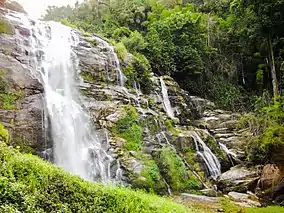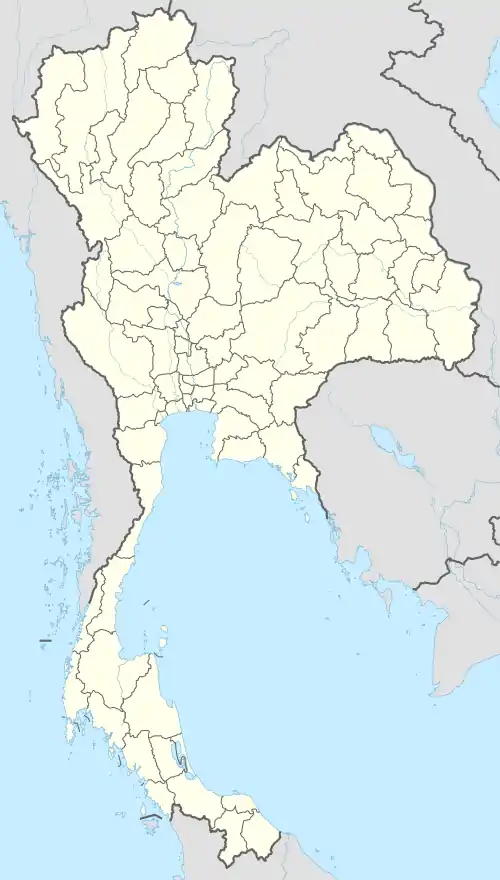Doi Inthanon National Park
Doi Inthanon National Park (Thai: อุทยานแห่งชาติดอยอินทนนท์),[2] nicknamed "the roof of Thailand", is in the Thanon Thong Chai Range, Chom Thong District, Chiang Mai Province, northern Thailand.[3] It includes Doi Inthanon, the country's highest mountain. It contains an area of 482 square kilometres (186 sq mi) in size.[4] It was established in October 2, 1972. [5]


| Doi Inthanon National Park | |
|---|---|
| อุทยานแห่งชาติดอยอินทนนท์ | |
IUCN category II (national park) | |
 The Wachirathan Waterfall, Doi Inthanon National Park, the highest point in Thailand | |
 Location within Thailand | |
| Location | Chom Thong District, Chiang Mai Province, Thailand |
| Coordinates | 18°35′32″N 98°29′12″E |
| Area | 482 km2 |
| Established | 2 October 1972 [1] |
| Governing body | Dept of National Parks |
| Website | Doi Inthanon NP |
Geography
The park is approximately 60 kilometres (37 mi) from Chiang Mai. It includes Karen and Meo Hmong villages of about 4,500 people.[6] Its elevation ranges between 800–2,565 metres (2,625–8,415 ft). Within its borders are a number of waterfalls: Mae Klang Falls, Wachiratan Falls, Siriphum Falls, and Mae Ya Falls.[3] The park has varied climatic and ecologically different sections.
Flora and fauna
Flora includes evergreen cloud forest, sphagnum bog, and deciduous dipterocarp forest.[4] There are some relict pines.[3] With 383 avifauna species,[7] it ranks second among Thailand's national parks in number of bird species.[8]
 Subtropical semi-evergreen seasonal forest at the end of the dry season
Subtropical semi-evergreen seasonal forest at the end of the dry season Cethosia biblis, Doi Inthanon National Park
Cethosia biblis, Doi Inthanon National Park An adult male green-tailed sunbird
An adult male green-tailed sunbird
Reptile species in Doi Inthanon National Park include:[9]
- Acanthosaura lepidogaster
- Gekko gecko
- Hemidactylus frenatus
- Hemidactylus platyurus
- Hemiphyllodactylus chiangmaiensis
- Ahaetulla prasina
- Hebius khasiense
- Trimeresurus popeiorum
- Cyrtodactylus inthanon[10]
Amphibian species in Doi Inthanon National Park include:[9]
Gallery
 The viewpoint at the 41st km of the Highway 1009, Doi Inthanon
The viewpoint at the 41st km of the Highway 1009, Doi Inthanon Doi Inthanon National Park
Doi Inthanon National Park Doi Inthanon National Park
Doi Inthanon National Park Doi Inthanon National Park
Doi Inthanon National Park Cherry blossom flowers all over the area at Doi Inthanon National Park
Cherry blossom flowers all over the area at Doi Inthanon National Park A scenic walkway in the area of Doi Inthanon National Park
A scenic walkway in the area of Doi Inthanon National Park Mae Ya Waterfall in Doi Inthanon National Park
Mae Ya Waterfall in Doi Inthanon National Park.jpg.webp) Siri Phum Waterfall in Doi Inthanon National Park
Siri Phum Waterfall in Doi Inthanon National Park Siri Than Waterfall in Doi Inthanon National Park
Siri Than Waterfall in Doi Inthanon National Park Waterfall in Doi Inthanon National Park
Waterfall in Doi Inthanon National Park
References
- http://www.ratchakitcha.soc.go.th/DATA/PDF/2515/A/148/5.PDF
- Pronunciation
- "Doi Inthanon National Park". Tourism Authority of Thailand (TAT). Archived from the original on 1 May 2015. Retrieved 1 May 2015.
- "Jungle Law in Thailand's Forests". New Scientist. 18 Nov 1989. pp. 43–. ISSN 0262-4079. Retrieved 20 Nov 2014.
- http://www.ratchakitcha.soc.go.th/DATA/PDF/2515/A/148/5.PDF
- Zeppel, Heather (2006). Indigenous Ecotourism: Sustainable Development and Management. CABI. pp. 237–. ISBN 978-1-84593-124-7. Retrieved 1 Oct 2011.
- Poultney, Trevor (1 Jan 2003). Environments: Asia Pacific. Curriculum Press. pp. 22–. ISBN 978-1-86366-567-4. Retrieved 1 Oct 2011.
- Elliot, Stephan; Cubitt, Gerald (2001). THE NATIONAL PARKS and other Wild Places of THAILAND. New Holland Publishers (UK) Ltd. pp. 62–67. ISBN 9781859748862.
- Kirati Kunya, Montri Sumontha, Nonn Panitvong, Wuttipong Dongkumfu, Thana Sirisamphan and Olivier S. G. Pauwels. 2015. A New Forest-dwelling Bent-toed Gecko (Squamata: Gekkonidae: Cyrtodactylus) from Doi Inthanon, Chiang Mai Province, northern Thailand. Zootaxa. 3905(4):573-584. [p.579] DOI: 10.11646/zootaxa.3905.4.9
- http://novataxa.blogspot.com/2015/01/cyrtodactylus-inthanon.html
External links
 Doi Inthanon National Park travel guide from Wikivoyage
Doi Inthanon National Park travel guide from Wikivoyage
| Wikimedia Commons has media related to Doi Inthanon National Park. |